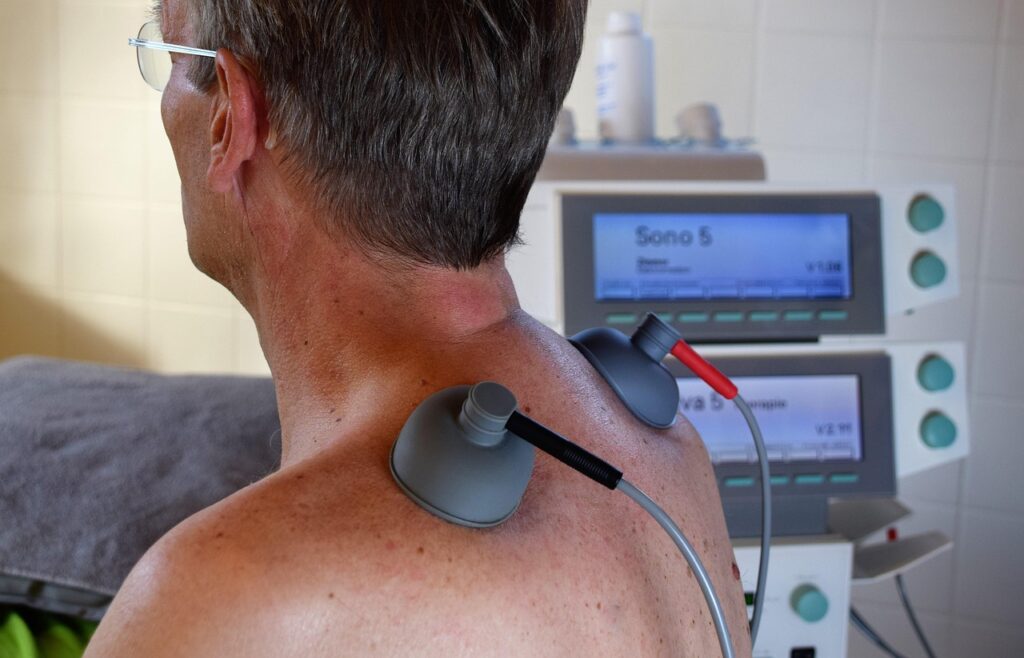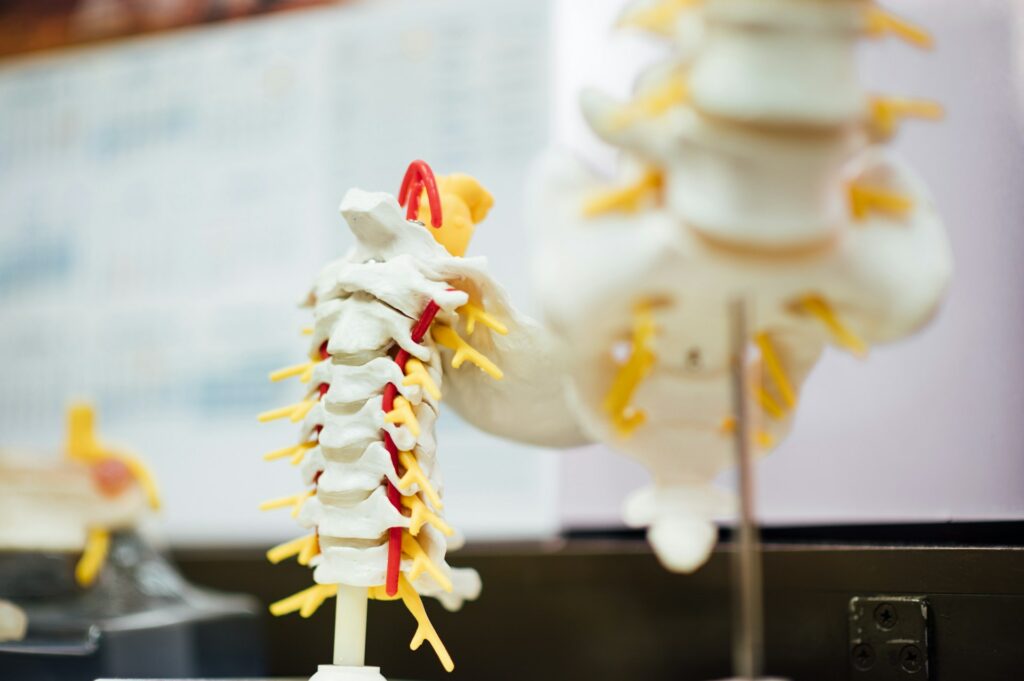The utilization of spinal cord stimulators in chronic pain management is revolutionizing the medical field, presenting an array of benefits that extend beyond mere pain alleviation. These devices offer a non-invasive approach, reduce dependency on medications, and greatly improve patients’ quality of life. As we explore the multifaceted advantages of spinal cord stimulators, the potential for a broader application in pain management becomes increasingly apparent, inviting further discussions and investigations.
Understanding Spinal Cord Stimulators
Delving into the domain of medical technology, spinal cord stimulators represent a significant leap forward in pain management. This innovative device operates on an intricate mechanism, designed to mitigate the debilitating effects of chronic back, limb, or nerve pain.
The mechanism overview is simple yet ingenious. The stimulator, once implanted, sends low-level electrical signals to the spinal cord or specific nerves. These signals disrupt the pain signals travelling to the brain, thereby reducing the sensation of discomfort. Given the complexity of this procedure, understanding the nuances of patient eligibility becomes essential.
Patient eligibility for spinal cord stimulators revolves around several key factors. Initially, patients must have endured chronic pain for a significant duration, typically over three to six months, with minimal to no relief from conventional pain management methods. Additionally, they must not have any existing conditions or circumstances that may complicate the procedure or recovery, such as untreated depression or drug addiction. A successful psychological evaluation is also a prerequisite.
Easing Chronic Pain
In the domain of chronic pain management, spinal cord stimulators serve as a beacon of hope for many patients. These devices, through a process known as neurostimulation therapy, can considerably alleviate neuropathic pain, a type of chronic pain that is notoriously difficult to treat.
Neuropathic pain arises from damaged or dysfunctional nerves that send incorrect signals to pain centers. Spinal cord stimulators counteract these signals by emitting a mild electrical current to the spinal cord, thereby modulating the pain signals before they reach the brain.
The application of spinal cord stimulators in easing chronic pain is underscored by several key advantages:
- Personalized Pain Management: Spinal cord stimulators can be programmed to target specific areas where pain is felt, offering individualized relief.
- Non-Invasive Treatment: While the device requires surgical implantation, the therapy itself is non-invasive, reducing the risk of complications.
- Reversible Procedure: If a patient does not derive benefit from the stimulator or if better treatments become available, the device can be safely removed.
For those seeking additional treatment options for neuropathy, how to alleviate neuropathy with advanced medical care could provide valuable insights.
Reduction in Pain Medication
Yet another significant advantage of spinal cord stimulators lies in their potential to reduce reliance on pain medications. This aspect is particularly remarkable, given the ongoing opioid crisis, driven by an over-reliance on prescription opioids for pain management. Reducing opioid dependency is an urgent public health priority, and spinal cord stimulators can play a pivotal role in this effort.
Spinal cord stimulators work by disrupting the pain signals sent to the brain, thereby alleviating the symptoms rather than masking them with pain medications. This shift from reactive pain management to proactive pain alleviation can lead to a substantial decrease in the consumption of opioids and other pain medications.
Additionally, cutting down on pain medications can mitigate the risk of medication side effects, which can range from mild discomfort to severe health complications. Long-term use of pain medication can lead to stomach ulcers, cardiovascular issues, and liver damage, among other health problems. Consequently, spinal cord stimulators not only reduce dependency on pain medications but also minimize the potential harm associated with their prolonged use. In cases where pain management becomes more complex, such as in Failed Back Surgery Syndrome, chronic pain can be effectively managed with innovative solutions.
Improved Physical Function
An often overlooked, yet critical advantage of spinal cord stimulators is their ability to improve physical function. This technology can greatly enhance the quality of life for individuals experiencing chronic pain by enabling them to perform daily activities more effectively.
This improvement in physical function comes in several forms:
- Increased strength and flexibility: The stimulators can stimulate muscles indirectly, leading to potential gains in strength and flexibility.
- Enhanced balance and coordination: By modulating the pain signals, these devices can also improve the user’s balance and coordination, contributing to overall mobility improvement.
- Greater endurance: The reduction in pain can enable individuals to engage in physical activities for longer periods, increasing their overall endurance.
These improvements are not only beneficial for individuals’ physical health but also for their mental and emotional well-being. Being able to perform daily activities without the constant presence of pain can provide a considerable boost to self-esteem and overall mood. Hence, the improved physical function offered by spinal cord stimulators goes beyond mere mobility improvement – it can fundamentally improve an individual’s quality of life. For those dealing with persistent back pain, you can find relief with back pain treatments tailored to your needs. However, it is essential to remember that the effectiveness of spinal cord stimulators can vary between individuals, and consultation with a healthcare professional is recommended before considering this form of treatment.
Enhanced Sleep Quality
Building on the physical benefits offered by spinal cord stimulators, another remarkable advantage they provide is enhanced sleep quality. The efficacy of these devices in improving sleep patterns is increasingly recognized by the medical community.
When chronic pain is mitigated by the stimulator, individuals often experience deeper, more restful periods of sleep. This is primarily due to the reduction in pain-related sleep interruptions, allowing for more consistent and uninterrupted sleep patterns. The effects of improved sleep should not be underestimated. Adequate sleep is essential for overall health and well-being, and for chronic pain sufferers, it can greatly improve their quality of life.
Spinal cord stimulators work in tandem with relaxation techniques to foster a conducive environment for sleep. They can help to modulate the body’s pain signals, enabling individuals to focus on relaxation techniques without the distraction of discomfort. This forms a positive feedback loop, wherein better sleep aids in pain management and reduced pain leads to improved sleep.

Customizable Pain Relief
One significant advantage of spinal cord stimulators is their ability to offer customizable pain relief. This personalization feature proves to be a key factor in enhancing patient satisfaction, as it allows for a tailored approach to pain management.
The device settings can be easily adjusted to cater to the unique pain threshold and pain pattern of each patient. This flexibility allows for a more targeted and effective pain management strategy, potentially reducing the need for systemic pain medication. This is pivotal as it allows for a more sustainable, long-term solution for chronic pain sufferers.
Some key advantages of this customizable approach are: – Individualized treatment: The ability to adjust the device settings enables a personalized treatment plan. – Enhanced patient control: Patients can modify the intensity of stimulation based on their comfort level. – Adaptable therapy: The device can be recalibrated to accommodate changes in pain pattern over time.
The ability to customize pain relief is a critical step forward in the field of pain management, potentially improving the overall quality of life for patients. It highlights the importance of patient-centered care and reaffirms the role of technology in enhancing healthcare outcomes.
Non-Invasive Treatment Option
Moving beyond the individualized nature of spinal cord stimulators, its non-invasive characteristic is another important advantage worth consideration. Unlike traditional pain management methods that often involve invasive surgeries with potential risks and lengthy recovery periods, spinal cord stimulators offer a less intrusive solution. The procedure typically involves the implantation of a small device near the spinal cord, which emits low-level electrical impulses to help manage pain.
One vital aspect that enhances the appeal of spinal cord stimulators is patient eligibility. Since the treatment is non-invasive, it broadens the scope of patients who qualify for it. Patients who are not suitable candidates for surgery due to various health complications can consider this as a viable alternative. Furthermore, patients who prefer avoiding the potential risks and discomfort associated with surgery may also find this option appealing.
When considering therapy duration, spinal cord stimulators again demonstrate their superiority. The devices are designed for long-term use, providing sustained relief from chronic pain. This element of permanence, coupled with the non-invasive nature of the therapy, allows patients to regain control over their lives without the constant interruption of recurring pain or invasive treatments. Consequently, the non-invasive nature of spinal cord stimulators markedly enhances their overall appeal and effectiveness.
Cost Effectiveness of SC Stimulators
Understanding the cost effectiveness of spinal cord stimulators requires an extensive analysis of both short-term and long-term financial implications. From the initial investment to the ongoing costs, it is vital to take into account all financial aspects of spinal cord stimulators.
- Initial investment: The upfront cost of a spinal cord stimulator can be significant. However, most insurance coverage plans can assist in mitigating these initial expenses.
- Ongoing costs: Maintenance, battery replacements, and periodic check-ups are necessary for the longevity and effectiveness of the device. These recurring costs may seem burdensome, but they are much lower compared to the potential costs of long-term medication or further invasive surgeries.
- Long term savings: Over time, the cost of managing chronic pain with medication can far exceed the total cost of a spinal cord stimulator. Additionally, spinal cord stimulators can reduce the need for further treatment, leading to significant long-term savings.
Frequently Asked Questions
Can Spinal Cord Stimulators Help With Conditions Other Than Chronic Pain?
Yes, beyond chronic pain management, spinal cord stimulators have alternative uses. They offer neurological benefits such as improving vascular disease symptoms and controlling bladder function, expanding their therapeutic potential considerably.
What Are the Potential Side Effects or Risks of Spinal Cord Stimulators?
Potential safety concerns of spinal cord stimulators include device complications such as lead migration, infection, and hemorrhage. Some patients may also experience discomfort or ineffective pain relief due to incorrect device programming or positioning.
How Long Does a Spinal Cord Stimulator Device Last Before Needing Replacement?
The lifespan of a spinal cord stimulator device typically ranges from 5 to 10 years, depending on usage. Consequently, replacement frequency is approximately every 5 to 10 years, ensuring ideal performance and therapeutic benefit.
How Does the Implantation Procedure for a Spinal Cord Stimulator Work?
The implantation procedure for a spinal cord stimulator involves precise placement of electrodes in the epidural space, using advanced imaging techniques. Post-procedure, detailed recovery guidelines are provided to guarantee ideal device functionality and patient comfort.
Can I Use a Spinal Cord Stimulator if I Have Other Implanted Medical Devices?
Yes, it’s possible to use a spinal cord stimulator with other implanted medical devices. However, compatibility concerns and potential device interactions should be carefully evaluated with your healthcare provider to guarantee safe and effective usage.
